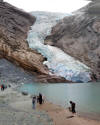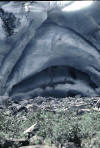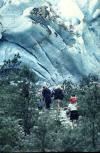About Glacier's
This photos come from the
Briksdal and the Kjendal glaciers
at the end of the Olden and Loen valley.
Those glaciers are a part of the biggest glacier on the European continent.
The mighty Jostedal Glacier.
Glacier's are accumulated
ice and snow that can be several thousands years old. If winters are
strong, and a lot of snow falls on the glacier, and if it does not melt within
the summer, the glacier will grow. If the warm summer manage to melt
more snow than came in the wintertime, the glacier will shrink.
You
will not see the response of snowfalls before 3 to 5 years after. The
glacier may advance as much as 50 - 60 m / year! but it may also shrink
that much. As it advances, it will wipe away everything that stand
in its way. from sand and soil to giant stones and trees. Everything
is mashed and shovelled away, and mixed together in the big heap in
the glacial deposit at the glacier front.
Some years ago, a log of wood was found in
the front of a glacier, Carbon tests proved that it was about 8000
years old! This indicates that the area under the glacier - that
now several hundred meters thick - once upon a time was covered by
forests, instead of ice and snow. At the fall, year 2006, the
glacier had "pulled back" more then 150m during the last years.
300 - 400 years earlier, however, The glacier reached almost 2000 m down
the valley. In the 60's it had pulled back way up in the cliff. And that was long before anyone talked about "Global Warming"
or "Greenhouse effect ". Well, now it is on it's way back
to the cliff. Due to the lack of snow fall in the winters last years.
As you see, the glacier's will be in constant movement. It may be
similar with a ice cold, hard dough that is sliding downhill by it's own
weight. At the front it will break up in larger and minor
fragments that now and than is falling down with a mighty thunder.
Therefore, please keep a distance to the glacier. If you want to walk on
the glacier, you will find guided tours. Never go on our own. If
you should fall down in one of the cracks, and you are on your own, you
may die of the frost from the glacier before the rescue, if you're still
alive after the falling. And where should people look for you when
you at last should be reported missing ?
And where should they find you, hidden several meters under the surface in
a crack ???
Even if you will see some people almost walking into the glacier, don't
follow! If you ignore the warning-signs and the barrier ropes, you will be
responsible for your own security.
People
have been crushed to juice under Huge blocks of ice falling down from another glacier some years ago. and it
is no use looking for them. They just wanted to have some pictures taken as
memory.
In June 2001, a young man fall trough a snow bridge covering a crack in
one of the branches of the Jostdal Glacier. His friends had to leave him
to alert a rescue team. He stayed in the crack for 5 - 6 hrs. and died
the following day in the hospital. He came only 30 m from the edge of the
glacier, walked un-secured, and was not dressed for glacier walks at
all. He was considered as an experienced hill - and glacier walker, but careless
and may be reckless.
The glacier has, however started to grow again, and now it is rated as dangerous to climb, due to masses of ice falling down from the top. Last years there has come a lot of snow in the mountain areas. So it may grow for another year or two.
Up to the mouth of the Kjendal Glacier
ATT! Don't move
too close.
It may eat you, and there will be no return!
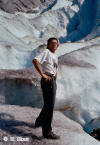
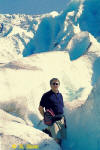
This IS too close!!
From the Briksdal Glacier
(Notice the cracks in the glacier)

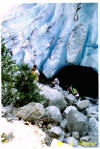
Just imagine if something should have be falling down. . .
Briksdal Glacier
2007
As you can see, it was not much left.of it.
